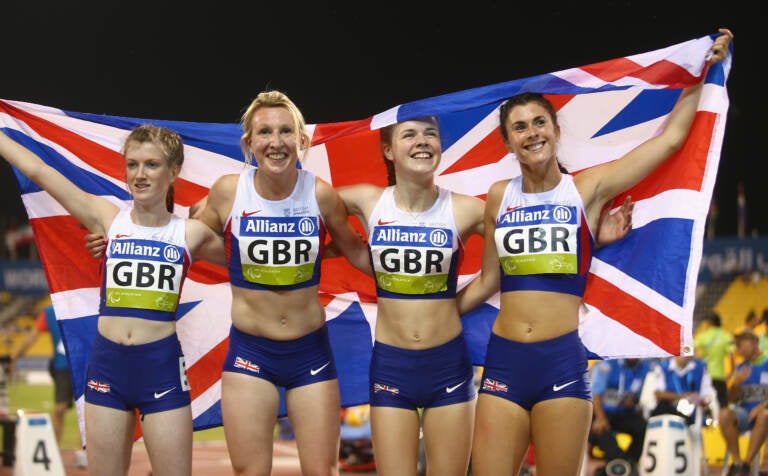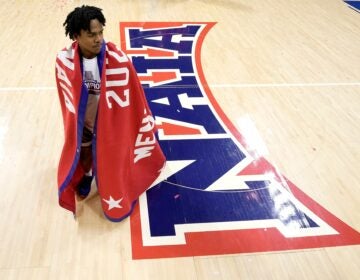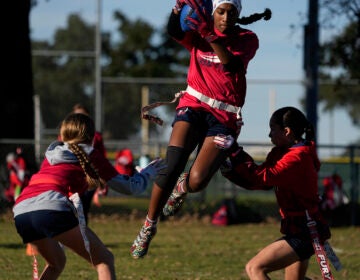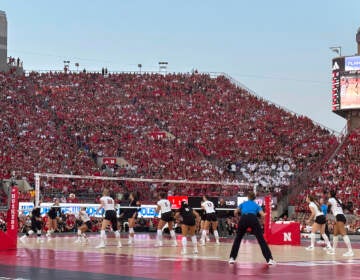The sexualization of women in sports extends even to what they wear

Olivia Breen (right), a Welsh Paralympian seen here in 2015, recently recounted a competition official remarking that her briefs were "too short and inappropriate." Here, she, along with Sophie Hahn (from left), Georgina Hermitage and Maria Lyle of Great Britain, celebrate winning gold in the women's 4x100m T35-38 relay final of the IPC Athletics World Championships in Doha, Qatar, in 2015. (Francois Nel/Getty Images)
It’s 2021, but the policing of female athletes’ bodies is a practice that continues to thrive.
The Norwegian women’s beach handball team is in a battle with the sport’s governing bodies to wear less-revealing uniforms. After the team’s repeated complaints about the required bikini bottoms were reportedly ignored, they wore shorts during a recent game in protest and were fined 150 euros (around $175) per player.
It’s similar in theme to another trending story: Welsh Paralympian Olivia Breen recently recounted a competition official remarking that her briefs were “too short and inappropriate.” Sharing her story led other female athletes who have experienced similar body policing to do the same, she said on Instagram.
It has been a shock to many that women athletes are still having to fight such battles, but to some, it’s no surprise at all.
Women athletes often don’t have the same options
For retired soccer player Briana Scurry, the ordeal that the Norwegian team is facing is “enraging” and “absurd” — and not unfamiliar, she told NPR. Scurry, who has played in three World Cups and has two Olympic gold medals, recalled representing the U.S. in the Olympics in the 1990s and the women’s team having to wear “hand-me-down jerseys and shorts from the men’s team” because the sponsor made the uniforms with only the male team in mind.
The women’s skill had earned them a presence on a global stage, yet they were stuck wearing ill-fitting uniforms — an unnecessary distraction that can be demoralizing.
“You should feel like a superhero in it because you’re representing in a very special and positive and powerful way, and [you shouldn’t] have to worry about the cut of the short,” Scurry said.
Unfortunately, unreasonable expectations aren’t new. One of the most egregious offenses occurred in 2012, when the Badminton World Federation tried (and failed) to force female players to wear skirts in order to “look feminine and have a nice presentation.”
On the flip side, the International Volleyball Federation softened its regulations in 2016 to allow players to wear hijabs in a bid to make the sport more welcoming.
In general, the strictness of any sport’s dress code is dependent on its governing body. It’s why some female athletes may have a range of uniform options to choose from, while others, like the Norwegian women’s beach handball team, still find themselves battling antiquated dress codes.
Change needs to start early
Women being judged on their perceived femininity rather than their athleticism is a symptom of a bigger problem. Sports are often a “microcosm of our society,” said Akilah Carter-Francique, the executive director for the Institute for the Study of Sport, Society and Social Change at San José State University.
“There are those societal expectations that fall in line with gender norms that are couched in patriarchy about how women should present themselves. … From hair to makeup to clothing, to how tight [or loose] the clothing is, to the colors,” Carter-Francique told NPR. “[All] so that they can be more in line with this notion of girlhood, of womanhood, of what is deemed femininity.”
Having to combat sexist standards that echo what they’re already dealing with isn’t the only thing that can turn girls away. A lack of access and cultural stigma also contribute to low participation numbers, according to a report from the Women’s Sports Foundation, and girls who do stick with sports may find themselves in programs that receive less attention and funding.
A change in culture needs to happen, Scurry said.
“It starts with the dollar, and it starts with the seed — not the fruit,” Scurry said. “If you were planting 100 seeds and you plant 98 on one side and two on the other? Good luck with the harvest on the other side. … You have to be a lot more fair in the beginning, not at the end.”
9(MDAzMzI1ODY3MDEyMzkzOTE3NjIxNDg3MQ001))




